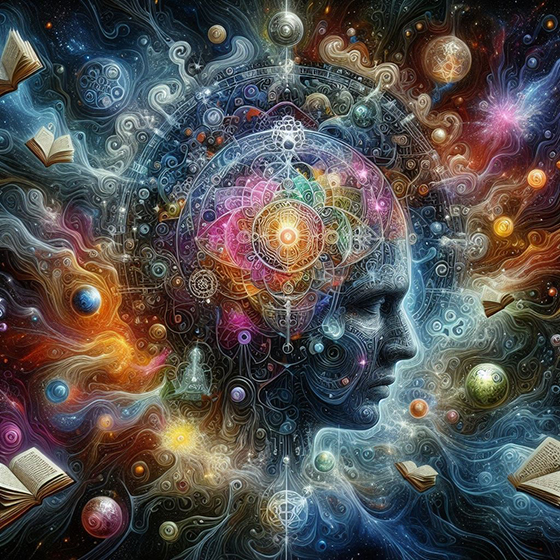| Esoterik.se | Home | Main menu | Swedish version | mail: mats@esoterik.se |
The conciousness of man
We can categorize mans conscionusness in several different ways. One way is speaking about objective, subjective and latent consciousness. But we can also separate physical, emotional, mental and causal consciousness. Besides that we can mention waking consciousness, subconsciousness and superconsciousness. All these types of consciousness are connected, so we canīt separate one type from the other, but we must understand them all. Waking consciousness, subconsciousness and superconsciousness. The waking consciousness is fairly easy to define. This is simply our usual thoughts, emotions and whatever we feel with our physical senses when we are awake. The subconscious can be seen as a "paperbasket" where we through everything we have experienced. Then when we sleep things can turn up from our subconscious in our dreams. The most recent events can be at the top of the paperbasket, so we might get them easiest. This is the reason why many people mostly dream about what has happened during the day, often quite disordered. The subconscious is well known by modern psycology. On the other hand, the superconscious is less known by our psycologists. But one who mentioned it was the psycologist C.G.Jung. Unlike the subconscious the superconscious behaves "intelligent" and provides sensible messages, often as symbols. Here we can get information about ourselves, pure precognitive dreams etc. Many times the information comes in the form of archetypes, common symbols for most people in one civilization. A study of C.G.Jungs descriptions of archetypes can be a good help here, and increase the understanding of ones own dreams. The consciousness of man We can categorize mans conscionusness in several different ways. One way is speaking about objective, subjective and latent consciousness. But we can also separate physical, emotional, mental and causal consciousness. Besides that we can mention waking consciousness, subconsciousness and superconsciousness. All these types of consciousness are connected, so we canīt separate one type from the other, but we must understand them all. |
Waking consciousness, subconsciousness and superconsciousness. The waking consciousness is fairly easy to define. This is simply our usual thoughts, emotions and whatever we feel with our physical senses when we are awake. Physical, emotional and mental consciousness. The physical consciousness could simply be described as everything we see, hear and feel with our physical body with its senses. It makes us aware of the world we live in. The emotional consciousness is the consciousness of the emotions. Everything we can call "emotional experiencies" is emotional consciousness. The ability to control our emotions, being able to reduce "lower emotions" as envy etc. and replace them with "higher" as for example devotion indicates emotional consciousness control. All emotions and expressions we have, creates a print (a so called elemental) in the emotional world, which other people can register subjectively or objectively, depending on their own ability. When we solve a crossword, or work on a mathematical problem our mental thinking is activated. The most basic mental thinking is the power of deduction. If we do this the result will be that. Later on the ability to solve more complex mental problems develops, like doing studies or deeper understanding. On the highest mental levels, which man doesnīt reach until he has mastered the highest emotional, his perspective and system thinking develops to such a degree that he is seldom fully understood by the large mass, or even by searchers and mystics on the highest emotional levels. In the same way as in the emotional world, mental activity creates a print in the mental world. This means that we actually have a responsibility not only for the things we do, but also for what we feel and think. Everything we bring about affects our surroundings. Causal consciousnessA person can only understand levels of consciousness that he has experienced for himself. A level thatīs above the own experience is basically impossible to understand. The causal consciousness is extremely rare on humanitys present average level, and therefore very difficult to describe or understand. One person who is told to have had causal consciousness was Helena P. Balvatsky, founder of the Theosophical movement in the late 19th century. Among other things, she had the ability to report any text from any book in the world, without ever having read it. Her objective consciousness in the causal world gave her acces to all known knowlegde on Earth, and all she had to do was to reproduce it. Probably one has to experience something simular before fully understanding it, but it is a fact that H.P.B. demonstrated this ability over and over again for any scientists who wanted to test her. The subconscious can be seen as a "paperbasket" where we through everything we have experienced. Then when we sleep things can turn up from our subconscious in our dreams. The most recent events can be at the top of the paperbasket, so we might get them easiest. This is the reason why many people mostly dream about what has happened during the day, often quite disordered. The subconscious is well known by modern psycology. On the other hand, the superconscious is less known by our psycologists. But one who mentioned it was the psycologist C.G.Jung. Unlike the subconscious the superconscious behaves "intelligent" and provides sensible messages, often as symbols. Here we can get information about ourselves, pure precognitive dreams etc. Many times the information comes in the form of archetypes, common symbols for most people in one civilization. A study of C.G.Jungs descriptions of archetypes can be a good help here, and increase the understanding of ones own dreams. Edited by Peter Astarci |
